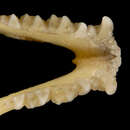en
names in breadcrumbs


Lasiurus intermedius is sometimes referred to by several different common names. These names include: Northern Yellow Bat, Eastern Yellow Bat, and Florida Yellow Bat.
Perception Channels: tactile ; chemical
Lasiurus intermedius is generally considered to be a rare bat, although it is common across the state of Florida. Its major population threat comes from the destruction of their habitats (forest trees, palms, etc.) by humans. (Department of Wildlife Ecology and Conservation, 1997).
Temperate North American bats are now threatened by a fungal disease called “white-nose syndrome.” This disease has devastated eastern North American bat populations at hibernation sites since 2007. The fungus, Geomyces destructans, grows best in cold, humid conditions that are typical of many bat hibernacula. The fungus grows on, and in some cases invades, the bodies of hibernating bats and seems to result in disturbance from hibernation, causing a debilitating loss of important metabolic resources and mass deaths. Mortality rates at some hibernation sites have been as high as 90%. While there are currently no reports of Lasiurus intermedius mortalities as a result of white-nose syndrome, the disease continues to expand its range in North America.
CITES: no special status
IUCN Red List of Threatened Species: least concern
Bats, in general, have been known to roost in accessible attics or roofs. This can lead to an inconvenient economic "burden" that is limited to barring the entrance to the roosting site. Lasiurus intermedius , however, does not generally roost outside of a tree or a clump of Spanish moss.
Lasiurus intermedius provides a significantly greater benefit to humans than it does harm. By eating a large amount of insects, particularly mosquitoes, the bats eliminate potentially detrimental elements: insect consumption can reduce agricultural output, and insects (in particular, mosquitoes) can carry dangerous, and even fatal, diseases. (Taylor).
Lasiurus intermedius is a nocturnal insectivore that locates its prey through echolocation. Specifically, the Northern Yellow Bat preys upon leafhoppers, dragonflies, diving beetles, ants, and mosquitoes. It forages over open, grassy areas, such as pastures, lake edges, golf courses, and forest edges. (Allen, 1997).
Lasiurus intermedius is found only in the United States of America, with a range spanning along the southern coastal plains of the Atlantic and the Gulf of Mexico. The Northern Yellow Bat is found from Virginia down to Florida and to the Southern tip of Texas, as far inland as Austin. (GA Museum of Natural History, 1999).
Biogeographic Regions: nearctic (Native )
Lasiurus intermedius primarily roosts in Spanish moss, Tillandsia usneoides, but it also uses trees--often dead palm fronds. It generally inhabits hardwood and pine forests in permanent water, but is also found in pine groves. One oak tree with Spanish moss may harbor several bats. (GA Museum of Natural History, 1999; Organization for Bat Conservation).
Terrestrial Biomes: forest
Lasiurus intermedius gets its name from its yellow-orange to yellow-brown fur. It has long, silky fur only on the anterior half of its dorsal surface. The body is ventrally compressed and it has a short neck. The underside and its thin, wing membrane (patagium) are nearly naked. It has elongated hands, each with a thumb and four fingers. These elongated metacarpal and phalanges bones help to spread and control the wings. The hip joint in rotated 90 degrees--the legs project sideways and the knees are almost backwards. This formation is thought to assist the bats when alighting upside down and hanging by their toes. The length of the maxillary toothrow is usually more than 6.0 mm. The females are larger than the males (a sexually dimorphic species). The average total length of the Northern Yellow Bat is approximately 118-129 mm.
(Allen, 1997; GA Museum of Natural History, 1999; Simmons, 1999; Taylor).
Range mass: 17 to 22 g.
Other Physical Features: endothermic ; bilateral symmetry
Lasiurus intermedius breeds in late fall; however, fertilization and embryo development do not occur until the following spring (specifically referred to as "delayed fertilization"). The females generally carry 3-4 embryos, but only 2-3 young are born. Birth occurs in late May/early June. The young are born naked and helpless with small and undeveloped wings, but they mature and grow rapidly and are generally able to take to flight by late June of the year they are born. The complete extent of the mating season and its reproduction is not fully understood. The females do not take the young out on nocturnal flights but may transport them if the daytime roosts are disturbed. (Allen, 1997; GA Museum of Natural History, 1999; UC Berkeley, 1995).
Range number of offspring: 1 to 4.
Key Reproductive Features: seasonal breeding ; gonochoric/gonochoristic/dioecious (sexes separate); sexual ; viviparous